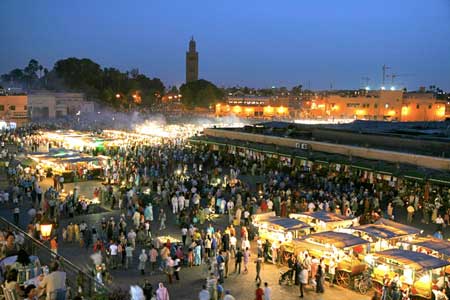Posts Tagged ‘Marrakech Travel Tour’
How does the Ramadan fast affect tourists traveling to the Imperial Cities, the Sahara Desert and other regions of Morocco during this high holy holiday? Can tourists eat or drink in public during Ramadan? This article should clear up the confusion on this issue for tourists, to explain the most polite solutions for tourist behavior at this time, and to assure tourists that there is no problem with them visiting Morocco during Ramadan. Because the Islamic calendar is lunar, holidays such as Ramadan advance by approximately ten days with each subsequent year. This means that Ramadan makes a cycle through the entire calendar of twelve months each twenty-some years. This year, Ramadan started on August 12th, 2010 in Morocco. The fast presently starts in Morocco at approximately 4:30 AM, and ends in the evening at approximately 7:30 PM.
Absolute Morocco is the most exciting tour (Book a Tour or call (800) 787-8806) to take for first time travelers to Morocco. Absolute Morocco takes you on an entertaining, fascinating and exotic journey to Morocco’s Imperial Cities of Marrakech, Fes and Meknes while including a visit to other historic cities such as Volubilis and Ouarzazate. When traveling on the Absolute Morocco tour you will visit the Berber capital of Ouarzazate, often referred to as “the door to the desert” and the Hollywood of Morocco. Ouarzazate is where famous directors and films have been shot such as Bertolucci’s Sheltering Sky, Martin Scorsese’s Kundun,, Ridley Scott’s Gladiator, Oliver Stone’s Alexander The Great and Ridley Scott’s Kingdom of Heaven. Ouarzazate also lays claim to one of Morocco’s oldest Kasbahs, Ait Benhaddou.
Marrakech is the Paris of Morocco and known as the “red city” or Al Hamra. As the capital of tourism, Marrakech is Morocco’s leading Imperial city and one of the most exciting cities to travel to on vacation. The heart of Marrakech is the best place to begin your tour with its souks, lush gardens, historical monuments, museums, palaces, sacred tombs and snake charmers. Marrakech also offers some of the best shopping in Morocco at its souks located within the old medina. As a Moroccan traveler a visit to Marrakech is a must. Make sure to allow yourself a minimum of two-days and spend at least one with a Morocco Travel licensed guide.




